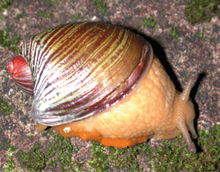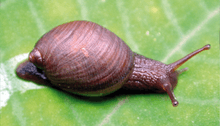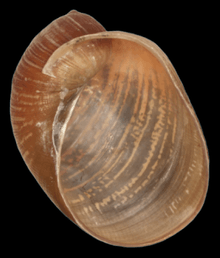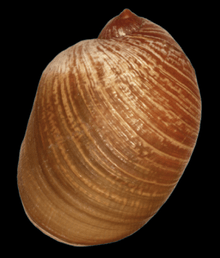Amphibulima patula
Amphibulima patula is a species of air-breathing land snail, a terrestrial pulmonate gastropod mollusk in the family Amphibulimidae.
| Amphibulima patula | |
|---|---|
 | |
| A live individual of Amphibulima patula dominicensis | |
| Scientific classification | |
| Kingdom: | |
| Phylum: | |
| Class: | |
| (unranked): | clade Heterobranchia clade Euthyneura clade Panpulmonata clade Eupulmonata clade Stylommatophora informal group Sigmurethra |
| Superfamily: | |
| Family: | |
| Genus: | |
| Species: | A. patula |
| Binomial name | |
| Amphibulima patula | |
| Synonyms | |
|
Bulimus patulus Bruguière, 1792 | |
Subspecies
Subspecies of Amphibulima patula include:
- Amphibulima patula patula (Bruguière, 1792)
- Amphibulima patula dominicensis Pilsbry, 1899[2] - Pilsbry (1899) separated the Dominican specimens on the basis of the darker colour and by having a heavier sculptured shell.[3] Robinson et al. (2009)[3] have found living specimens that were either light beige-coloured with a somewhat orange-yellowish line along the foot (see photo on the left), or entirely dark brown coloured (see photo on the right).[3]
Comparison of orange-yellowish and dark brown Amphibulima patula dominicensis:
 Live Amphibulima patula dominicensis |
 Live Amphibulima patula dominicensis |
Distribution
The nominate taxon Amphibulima patula patula has been reported from Guadeloupe (probably now extinct) and Marie-Galante.[3] The type locality is Guadeloupe.
Amphibulima patula dominicensis is endemic to Dominica.[3]
Another variety has been reported from Saint Kitts and Saba.[3]
Description
Amphibulima patula has large foot, that is not completely retracted into the shell in living specimen.[2] But when the live animal is immersed into the preserving fluid, then it retracts completely within the shell.[2]
Adult snail is about 2.5 cm.[4] It is called a slug-like snail because the shell is relatively small in proportion to the body and with one large, ear-like whorl and two small whorls.[4] Color is yellowish brown.[4]
This species could be confused with the common amber snails (Succinea), especially the juveniles.[4] The Amphibulima has much coarser sculpture than the amber snails.[4]
 apertural view of the shell of Amphibulima patula dominicensis |
 abapertural view of the shell of Amphibulima patula dominicensis |
The jaw and radula of Amphibulima patula dominicensis was described by Bland & Binney in 1874.[5]
Ecology
Amphibulima patula dominicensis is frequently found on banana and Citrus plants, where it may feed on the leaves.[3] They also eat leaves of Virginia pepperweed Lepidium virginicum and Cakile lanceolata.[2] They eat lettuce in captivity.[2]
References
This article incorporates public domain text from the reference [2] and CC-BY-3.0 text from the reference [3] and a public domain work of the United States Government from the reference.[4]
- Bruguière J. G. (1792). Encycl. meth. i, page 305.
-

- Robinson D. G., Hovestadt A., Fields A. & Breure A. S. H. (July 2009). "The land Mollusca of Dominica (Lesser Antilles), with notes on some enigmatic or rare species". Zoologische Mededelingen 83 http://www.zoologischemededelingen.nl/83/nr03/a13 Archived 2011-10-07 at the Wayback Machine
-

-

External links
| Wikimedia Commons has media related to Amphibulima patula. |